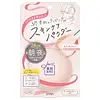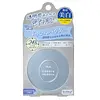What's inside
What's inside
 Key Ingredients
Key Ingredients

 Benefits
Benefits

 Concerns
Concerns

 Ingredients Side-by-side
Ingredients Side-by-side

Water
Skin ConditioningButylene Glycol
HumectantDipropylene Glycol
HumectantDiglycerin
HumectantMethyl Gluceth-20
HumectantBetaine
HumectantSoymilk Isoflavones
AntioxidantLactobacillus/Soymilk Ferment Filtrate
Skin ConditioningCeramide Ng
Skin ConditioningDipotassium Glycyrrhizate
HumectantArginine
MaskingCarbomer
Emulsion StabilisingXanthan Gum
EmulsifyingCitric Acid
BufferingSodium Citrate
BufferingCyclodextrin
AbsorbentPhytosterols
Skin ConditioningSodium Polyacrylate
AbsorbentPolyquaternium-51
Skin ConditioningMethyl Gluceth-10
EmulsifyingSucrose Laurate
EmollientPotassium Hydroxide
BufferingHydrogenated Lecithin
EmulsifyingPhenoxyethanol
PreservativeMethylparaben
PreservativeWater, Butylene Glycol, Dipropylene Glycol, Diglycerin, Methyl Gluceth-20, Betaine, Soymilk Isoflavones, Lactobacillus/Soymilk Ferment Filtrate, Ceramide Ng, Dipotassium Glycyrrhizate, Arginine, Carbomer, Xanthan Gum, Citric Acid, Sodium Citrate, Cyclodextrin, Phytosterols, Sodium Polyacrylate, Polyquaternium-51, Methyl Gluceth-10, Sucrose Laurate, Potassium Hydroxide, Hydrogenated Lecithin, Phenoxyethanol, Methylparaben
Aluminum Starch Octenylsuccinate
AbsorbentPentaerythrityl Tetraethylhexanoate
EmollientCellulose
AbsorbentZinc Myristate
Lauroyl Lysine
Skin ConditioningSilica Dimethyl Silylate
EmollientPhytosteryl/Octyldodecyl Lauroyl Glutamate
Skin ConditioningPentylene Glycol
Skin ConditioningPhenoxyethanol
PreservativeParfum
MaskingMethylparaben
PreservativeTocopherol
AntioxidantWater
Skin ConditioningSilica
AbrasiveButylene Glycol
HumectantAlgin
MaskingHydrolyzed Hyaluronic Acid
HumectantMaltodextrin
AbsorbentLactobacillus
Skin ConditioningSodium Hyaluronate
HumectantHydroxypropyltrimonium Hyaluronate
Scutellaria Baicalensis Root Extract
AstringentAnthemis Nobilis Flower Extract
MaskingRosa Damascena Flower Extract
MaskingCitric Acid
BufferingSoluble Collagen
HumectantSodium Citrate
BufferingTalc
AbrasiveSynthetic Fluorphlogopite
CI 77492
Cosmetic ColorantAluminum Starch Octenylsuccinate, Pentaerythrityl Tetraethylhexanoate, Cellulose, Zinc Myristate, Lauroyl Lysine, Silica Dimethyl Silylate, Phytosteryl/Octyldodecyl Lauroyl Glutamate, Pentylene Glycol, Phenoxyethanol, Parfum, Methylparaben, Tocopherol, Water, Silica, Butylene Glycol, Algin, Hydrolyzed Hyaluronic Acid, Maltodextrin, Lactobacillus, Sodium Hyaluronate, Hydroxypropyltrimonium Hyaluronate, Scutellaria Baicalensis Root Extract, Anthemis Nobilis Flower Extract, Rosa Damascena Flower Extract, Citric Acid, Soluble Collagen, Sodium Citrate, Talc, Synthetic Fluorphlogopite, CI 77492
Ingredients Explained
These ingredients are found in both products.
Ingredients higher up in an ingredient list are typically present in a larger amount.
Butylene Glycol (or BG) is used within cosmetic products for a few different reasons:
Overall, Butylene Glycol is a safe and well-rounded ingredient that works well with other ingredients.
Though this ingredient works well with most skin types, some people with sensitive skin may experience a reaction such as allergic rashes, closed comedones, or itchiness.
Learn more about Butylene GlycolCitric Acid is an alpha hydroxy acid (AHA) naturally found in citrus fruits like oranges, lemons, and limes.
Like other AHAs, citric acid can exfoliate skin by breaking down the bonds that hold dead skin cells together. This helps reveal smoother and brighter skin underneath.
However, this exfoliating effect only happens at high concentrations (20%) which can be hard to find in cosmetic products.
Due to this, citric acid is usually included in small amounts as a pH adjuster. This helps keep products slightly more acidic and compatible with skin's natural pH.
In skincare formulas, citric acid can:
While it can provide some skin benefits, research shows lactic acid and glycolic acid are generally more effective and less irritating exfoliants.
Most citric acid used in skincare today is made by fermenting sugars (usually from molasses). This synthetic version is identical to the natural citrus form but easier to stabilize and use in formulations.
Read more about some other popular AHA's here:
Learn more about Citric AcidMethylparaben is a preservative and is a paraben. It is used to prevent the growth of fungus, mold, and other harmful bacteria. Parabens are chemicals used as preservatives in both cosmetics and food.
Methylparaben can be synthetically created. It can also be found naturally in some fruits, such as blueberries.
Oftentimes, Methylparaben is combined with other parabens to help increase the shelf life.
The safety of Methylparaben is currently being studied. While ongoing studies are looking into the safety of parabens, the results have been very mixed. Some studies have not found Methylparaben to be harmful.
Learn more about MethylparabenPhenoxyethanol is a preservative that has germicide, antimicrobial, and aromatic properties. Studies show that phenoxyethanol can prevent microbial growth. By itself, it has a scent that is similar to that of a rose.
It's often used in formulations along with Caprylyl Glycol to preserve the shelf life of products.
Sodium Citrate is the sodium salts of citric acid. In skincare, it is used to alter pH levels and acts as a preservative.
Its main functions are to maintain the pH of a product and neutralize metal ions.
The acidity of our skin is maintained by our glands and skin biome; normal pH level of skin is slightly acidic (~4.75-5.5).
Being slightly acidic allows our skin to create an "acid mantle". This acid mantle is a thin barrier that protects our skin from bacteria and contaminants.
Learn more about Sodium CitrateWater. It's the most common cosmetic ingredient of all. You'll usually see it at the top of ingredient lists, meaning that it makes up the largest part of the product.
So why is it so popular? Water most often acts as a solvent - this means that it helps dissolve other ingredients into the formulation.
You'll also recognize water as that liquid we all need to stay alive. If you see this, drink a glass of water. Stay hydrated!
Learn more about Water